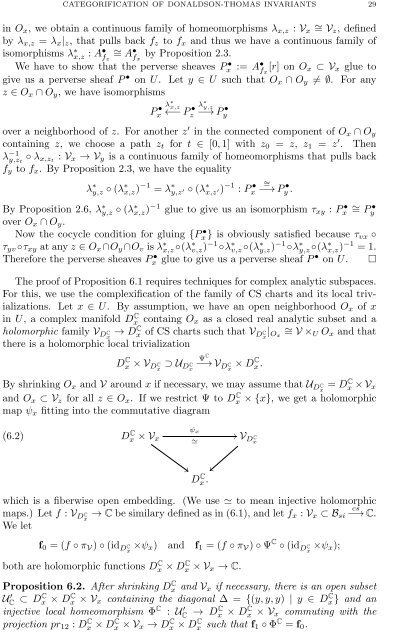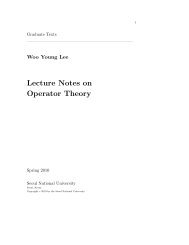Categorification of Donaldson-Thomas invariants via perverse ...
Categorification of Donaldson-Thomas invariants via perverse ...
Categorification of Donaldson-Thomas invariants via perverse ...
Create successful ePaper yourself
Turn your PDF publications into a flip-book with our unique Google optimized e-Paper software.
CATEGORIFICATION OF DONALDSON-THOMAS INVARIANTS 29in O x , we obtain a continuous family <strong>of</strong> homeomorphisms λ x,z : V x∼ = Vz , definedby λ x,z = λ x | z , that pulls back f z to f x and thus we have a continuous family <strong>of</strong>isomorphisms λ ∗ x,z : A • ∼f z = A•fxby Proposition 2.3.We have to show that the <strong>perverse</strong> sheaves P x• := A • f x[r] on O x ⊂ V x glue togive us a <strong>perverse</strong> sheaf P • on U. Let y ∈ U such that O x ∩ O y ≠ ∅. For anyz ∈ O x ∩ O y , we have isomorphismsP • xλ ∗ x,z←− P z• λ ∗ y,z−→ P y•over a neighborhood <strong>of</strong> z. For another z ′ in the connected component <strong>of</strong> O x ∩ O ycontaining z, we choose a path z t for t ∈ [0, 1] with z 0 = z, z 1 = z ′ . Thenλ −1y,z t◦ λ x,zt : V x → V y is a continuous family <strong>of</strong> homeomorphisms that pulls backf y to f x . By Proposition 2.3, we have the equalityλ ∗ y,z ◦ (λ ∗ x,z) −1 = λ ∗ y,z ′ ◦ (λ∗ x,z ′)−1 : P • x∼ =−→ P • y .By Proposition 2.6, λ ∗ y,z ◦ (λ ∗ x,z) −1 glue to give us an isomorphism τ xy : P x • ∼ = P y•over O x ∩ O y .Now the cocycle condition for gluing {P x • } is obviously satisfied because τ vx ◦τ yv ◦τ xy at any z ∈ O x ∩O y ∩O v is λ ∗ x,z ◦(λ ∗ v,z) −1 ◦λ ∗ v,z ◦(λ ∗ y,z) −1 ◦λ ∗ y,z ◦(λ ∗ x,z) −1 = 1.Therefore the <strong>perverse</strong> sheaves P x • glue to give us a <strong>perverse</strong> sheaf P • on U. □The pro<strong>of</strong> <strong>of</strong> Proposition 6.1 requires techniques for complex analytic subspaces.For this, we use the complexification <strong>of</strong> the family <strong>of</strong> CS charts and its local tri<strong>via</strong>lizations.Let x ∈ U. By assumption, we have an open neighborhood O x <strong>of</strong> xin U, a complex manifold D C x containg O x as a closed real analytic subset and aholomorphic family V D C x→ D C x <strong>of</strong> CS charts such that V D C x| Ox∼ = V ×U O x and thatthere is a holomorphic local tri<strong>via</strong>lizationD C x × V D C x⊃ U D C xΨ C−→ V D C x× D C x .By shrinking O x and V around x if necessary, we may assume that U D C x= Dx C × V xand O x ⊂ V z for all z ∈ O x . If we restrict Ψ to Dx C × {x}, we get a holomorphicmap ψ x fitting into the commutative diagram(6.2) D C x × V xψ x≃V D C xD C x .which is a fiberwise open embedding. (We use ≃ to mean injective holomorphiccsmaps.) Let f : V D C x→ C be similary defined as in (6.1), and let f x : V x ⊂ B si −→ C.We letf 0 = (f ◦ π V ) ◦ (id D C x×ψ x ) and f 1 = (f ◦ π V ) ◦ Ψ C ◦ (id D C x×ψ x );both are holomorphic functions D C x × D C x × V x → C.Proposition 6.2. After shrinking D C x and V x if necessary, there is an open subsetU ′ C ⊂ DC x × D C x × V x containing the diagonal ∆ = {(y, y, y) | y ∈ D C x } and aninjective local homeomorphism Φ C : U ′ C → DC x × D C x × V x commuting with theprojection pr 12 : D C x × D C x × V x → D C x × D C x such that f 1 ◦ Φ C = f 0 .













